The updated plan Tommy presented in the Situation Room on August 5, 2002, resolved several key concerns. We had lined up basing and overflight permission from leaders in the Gulf. Tommy had devised a plan for Special Operations to secure suspected WMD sites, Iraq’s southern oil fields, and Scud missile launchers. He had also designed a massive aerial bombardment that would make it costly for Saddam’s elite Republican Guard units to remain in the capital, reducing the chances of a Fortress Baghdad scenario. “Mr. President,” Tommy said in his Texas drawl, “this is going to be shock and awe.”
There were plenty of issues left to resolve. We all worried about the possibility of Saddam launching a biological or chemical attack on our troops, so the military was in the process of procuring hazmat suits. We had gradually increased the level of troops and equipment in Kuwait under the guise of training and other routine exercises, which would make it possible to begin combat operations rapidly if I gave the order to launch. Joint Chiefs Chairman Dick Myers talked about the importance of persuading Turkey to open its territory so we could establish a northern front. George Tenet raised concern about a broader regional war in which Syria attacked Israel, or Iran directed its proxy terrorist group, Hezbollah, to foment instability. Don Rumsfeld pointed out that a war could destabilize Jordan and Saudi Arabia, that America could get stuck in a manhunt for Saddam, and that Iraq could fracture after liberation.
Those potential scenarios were sobering. But so were the briefings we were receiving. A report in July read, “Iraq has managed to preserve and in some cases even enhance the infrastructure and expertise necessary for WMD production.” Another briefing warned that Saddam’s regime was “almost certainly working to produce the causative agent for anthrax along with botulinum toxin, aflatoxin, and ricin.” It continued: “Unmanned aerial vehicles give Baghdad a more lethal means to deliver biological … weapons.” It went on, ominously, “Experience shows that Saddam produces weapons of mass destruction to use, not just to deter.”
In the summer of 2002, I received a startling piece of news. Abu Musab al-Zarqawi, an al Qaeda–affiliated terrorist who had experimented with biological weapons in Afghanistan, was operating a lab in northeastern Iraq. “Suspect facility in this area may be producing poisons and toxins for terrorist use,” the briefing read. “Al-Zarqawi is an active terrorist planner who has targeted U.S. and Israeli interests: Sensitive reporting from a [classified] service indicates that al-Zarqawi has been directing efforts to smuggle an unspecified chemical material originating in northern Iraq into the United States.”
We couldn’t say for sure whether Saddam knew Zarqawi was in Iraq. We did have intelligence indicating that Zarqawi had spent two months in Baghdad receiving medical treatment and that other al Qaeda operatives had moved to Iraq. The CIA had worked with a major Arab intelligence service to get Saddam to find and extradite Zarqawi. He refused.
The question was whether to bomb the poisons lab in the summer of 2002. We held a series of NSC meetings on the topic. General Dick Myers talked through the options: Tomahawk missiles, a B-2 bomber strike, or a covert ground raid. Dick Cheney and Don saw Zarqawi as a clear threat and argued that taking him out would reinforce the doctrine that America would not tolerate safe havens for terror.
Colin and Condi felt a strike on the lab would create an international firestorm and disrupt our efforts to build a coalition to confront Saddam—especially our attempt to recruit Turkey, which was highly sensitive about any activity in northeastern Iraq. “This would be viewed as a unilateral start to the war in Iraq,” Colin said.
I faced a dilemma. If America was hit with a biological attack from Iraq, I would be responsible for not having taken out the threat when we had the chance. On the other hand, bombing the camp could undermine diplomacy and trigger a military conflict.
I told the intelligence community to keep a close eye on the facility. For the time being, I decided to continue on the diplomatic track. But one thing was clear to me: Iraq was a serious threat growing more dangerous by the day.

I spent much of August 2002 in Crawford, a good place to reflect on the next decision I faced: how to move forward on the diplomatic track.
One option was to seek a UN resolution calling on Saddam to readmit weapons inspectors. The other was to issue an ultimatum demanding that he disarm—and rally a coalition to remove him if he did not comply.
From a legal standpoint, a resolution was unnecessary. Three years earlier, President Clinton and our NATO allies had removed the dictator Slobodan Milosevic from power in Serbia without an explicit UN resolution. Dick and Don argued we didn’t need one for Iraq, either. After all, we already had sixteen. They believed that going to the UN would trigger a long bureaucratic process that would leave Saddam even more dangerous.
I shared that concern. On the other hand, almost every ally I consulted—even staunch advocates of confronting Saddam like Prime Minister John Howard of Australia—told me a UN resolution was essential to win public support in their countries.
Colin agreed. The day before I left for Crawford, I asked him to meet with me privately in the Treaty Room. Colin was more passionate than I had seen him at any NSC meeting. He told me a UN resolution was the only way to get any support from the rest of the world. He went on to say that if we did take out Saddam, the military strike would be the easy part. Then, as Colin put it, America would “own” Iraq. We would be responsible for helping a fractured country rebuild. I listened carefully and shared Colin’s concern. It was another reason I hoped that diplomacy would work.
That summer, the possibility of war had become an all-consuming news story in Washington. Reporters asked frequently whether I had a war plan on my desk.
On August 15, I opened the Wall Street Journal to find a column by Brent Scowcroft, Dad’s national security adviser. It was headlined “Don’t Attack Saddam.” Brent argued that war with Iraq would distract from the war on terror and could unleash “an Armageddon in the Middle East.” His conclusion was that we should “be pressing the United Nations Security Council to insist on an effective no-notice inspection regime for Iraq.”
That was a fair recommendation. But I was angry that Brent had chosen to publish his advice in the newspaper instead of sharing it with me. I called Dad. “Son, Brent is a friend,” he assured me. That might be true. But I knew critics would later exploit Brent’s article if the diplomatic track failed.
Some in Washington speculated that Brent’s op-ed was Dad’s way of sending me a message on Iraq. That was ridiculous. Of all people, Dad understood the stakes. If he thought I was handling Iraq wrong, he damn sure would have told me himself.

On Saturday, September 7, 2002, I convened a meeting of the national security team at Camp David to finalize my decision on the resolution. Fifty-one weeks earlier, we had gathered in Laurel Lodge to plan the war in Afghanistan. Now we sat in the same room trying to find a way to remove the threat in Iraq without war.
I gave everyone on the team a chance to make their arguments. Dick Cheney recommended that we restate the case against Saddam, give him thirty to sixty days to come clean, and then disarm him by force if he refused to comply. “It is time to act,” Dick said. “We can’t delay for another year. … An inspection regime does not solve our problem.”
Читать дальше












